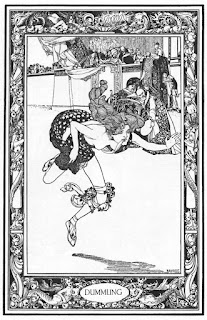Franz von Bayros (1866–1924), often called Marquis de Bayros was a painter and illustrator whose work was controversial thanks to strong erotic charge and spiking witticism, way over the standard in Victorian times. He was born in Zagreb (today's Croatia, then part of Austria) to noble parents who came from Spain. He studied at Vienna Academy of Fine Arts, where he moved among social elite, married Johann Strauss II step-daughter Alice and used the money from his first successful graphics to travel across Europe. His provocative work got him into trouble at authorities one exhibition after other but also built a reputation thanks to which he never ran out of work. Occasionally he used a pseudonym Choisy Le Conin.
Here are a few more interesting facts about this important artist:
- The artistic style of Franz von Bayros is a medley of Fin de siecle, Art Nouveaux, Roccoco and Goth fused into Decadence. Critics like to compare him with Aubrey Beardsley (1872-1898) and Felicien Rops (1833-1898). He was the most commercially successful of all three, with an exquisite sense for the composition and great attention to the details. Von Bayros was a master for creating atmospheres in his art. Despite cruising at the edge of perversity it certainly looks everybody in his illustrations is having a great time.
- Apart from illustrations, von Bayros excelled in one more area: at making bookplates (ex libris), made for numerous wealthy costumers, always unique, always personified as possible and always made in technique in which the maximum possible artistic effect was achieved. He lived in times with rapid development in printing technique and managed to master every new procedure right from the beginning.
- Most popular works by von Bayros are illustrated books among which the most outrageous was ‘Erzahlungen vom Toilettentisch’ (‘Tales from the Dressing Table’) from 1908. This book made him famous but his illustrations also caused a persecution from police in Munich and made him into exile from Germany. Other important works were Basile's Pentamerone (Vienna, 1909), Boccaccio's The Decameron (Berlin, 1910), Tales from the Thousand and One Nights (Berlin, 1913), and Dante's Divine Comedy (Vienna, 1921). The illustration above comes from Pentamerone's story titled The Booby (L'Ignorante). You can find a summary of this and many other tales from Pentamerone here:
http://goodstuffonly.joomla.com/2-uncategorised/3-pentamerone-by-giambattista-basile
(Illustration from German version of Pentamerone, eight tale from third day: The Booby)
Here are a few more interesting facts about this important artist:
- The artistic style of Franz von Bayros is a medley of Fin de siecle, Art Nouveaux, Roccoco and Goth fused into Decadence. Critics like to compare him with Aubrey Beardsley (1872-1898) and Felicien Rops (1833-1898). He was the most commercially successful of all three, with an exquisite sense for the composition and great attention to the details. Von Bayros was a master for creating atmospheres in his art. Despite cruising at the edge of perversity it certainly looks everybody in his illustrations is having a great time.
- Apart from illustrations, von Bayros excelled in one more area: at making bookplates (ex libris), made for numerous wealthy costumers, always unique, always personified as possible and always made in technique in which the maximum possible artistic effect was achieved. He lived in times with rapid development in printing technique and managed to master every new procedure right from the beginning.
- Most popular works by von Bayros are illustrated books among which the most outrageous was ‘Erzahlungen vom Toilettentisch’ (‘Tales from the Dressing Table’) from 1908. This book made him famous but his illustrations also caused a persecution from police in Munich and made him into exile from Germany. Other important works were Basile's Pentamerone (Vienna, 1909), Boccaccio's The Decameron (Berlin, 1910), Tales from the Thousand and One Nights (Berlin, 1913), and Dante's Divine Comedy (Vienna, 1921). The illustration above comes from Pentamerone's story titled The Booby (L'Ignorante). You can find a summary of this and many other tales from Pentamerone here:
http://goodstuffonly.joomla.com/2-uncategorised/3-pentamerone-by-giambattista-basile

Comments
Post a Comment